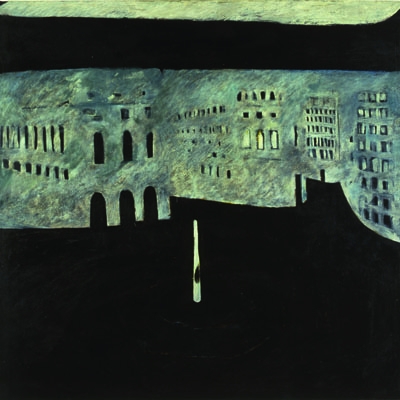Who was Conrad Marca-Relli? Figureheads of the so-called New York School such as Jackson Pollock and Mark Rothko have long since become art world icons — with attention-grabbing auction prices, fat biographies and plays or films about them to match. By comparison, few people in this country are likely to have heard of Marca-Relli. Tate Modern owns not a single work by him, nor has he ever had a solo exhibition in Britain. Yet Marca-Relli made a unique contribution to art at mid-century and was often at the heart of its action. He deserves a better fate.
Born to a family of Italian immigrants in Boston in 1913, Corrado di Marcarelli (he changed his name in the 1950s) moved to New York in 1926. Like many of the future abstract expressionists, during the Great Depression Marca-Relli worked for the New Deal’s WPA agency — a federal campaign to sponsor public artworks — where he met Franz Kline. Subsequently, in 1949 Marca-Relli played a key role in organising the ‘Eighth Street Club’, a lively discussion group that encompassed a broad swathe of New York artists and intellectuals, as well as the legendary ‘Ninth Street Show’ featuring not just the first comprehensive presentation of abstract expressionism, but also such rising stars as Helen Frankenthaler and Robert Rauschenberg. Perhaps most dramatically, it was Marca-Relli who was the first person to identify Pollock’s body at the scene of his car crash on 11 August 1956. But ultimately Marca-Relli bucked too many trends to fit the right niche in the historical record.
One reason why Marca-Relli has been written out of the picture is that, literally and imaginatively, he migrated between two continents. During the Cold War it helped the establishment if American artists were rubber-stamped with gung-ho nationalist credentials. A classic example of this stereotyping was the critic Clement Greenberg’s characterisation of abstract expressionism as ‘“American-Type” Painting’, the title of his highly influential 1955 essay. Inconveniently, however, Marca-Relli (the son of a peripatetic international journalist) constantly made trips to France, Italy and Spain; settled permanently in Palma three years before his death in 2000; and, disastrously for his critical fortunes, always insisted that the culture of the New World was thoroughly cosmopolitan, arising from a perennial dialogue with age-old European traditions.
Here this writer must disclose his own mea culpa. When writing my first history of abstract expressionism, published by Thames and Hudson in another century, I myself omitted Marca-Relli! Since then I have seen the proverbial light, especially once the veteran critic Bruno Alfieri (probably the earliest European commentator to recognise Pollock’s prodigal breakthrough) approached me five years ago to help curate a large Marca-Relli retrospective at the 18th-century Rotonda della Besana in Milan. The latest upshot of that project is the imminent show at Ronchini Gallery in London, done in collaboration with the artist’s key archival holdings in Parma and the San Francisco Chronicle’s art critic Kenneth Baker (a Brit and a Yank make a rather apt curatorial pairing for this transatlantic artist).
Although it is impossible to do full justice to Marca-Relli in any relatively compact installation, we have sought to represent the major dimensions of his vision. A chiselled early canvas exemplifies the artist’s preoccupation with architecture, stemming from the metaphysical cityscapes of Giorgio de Chirico. This focus upon tectonic forces reached a climax in the late 1950s. By then Marca-Relli was at the height of his powers, his art poised between a sense of violent destruction and a profound concern with how the parts of reality, both in the real world and as reimagined in terms of pictorial planes on the canvas, fit together. Constant references to the human body — effaced into blank shapes, ripped apart and deftly recombined — populate these tumultuous compositions. The selection includes the landmark ‘Death of Jackson Pollock’ (1956), an elegiac horizontal scene that evokes some fallen, broken presence without specifying it. Ambiguity meant everything to Marca-Relli.
Also clearly evident should be Marca-Relli’s gifted handling of colour. He was able to go, with a nod to Morandi’s palette, from the most austere grisaille to full-throttle Mediterranean hues inspired by nature. Two sentinel-like sculptures give a taste of his ideas in three dimensions.
Above all, the exhibition should demonstrate Marca-Relli’s greatest legacy, which was to raise the technique of collage — hitherto associated with the small scale at which Picasso and Braque had originated it — to the monumentality of abstract expressionism at its most ambitious. Cutting his materials (which ranged from raw canvas to vinyl) with a razor, Marca-Relli created an architectonic universe of electrifying edges, much as Pollock had transformed poured paint into zinging labyrinths. In the grand modern galleries of New York’s Metropolitan Museum of Art, Marca-Relli’s ‘The Battle’ holds its own against Pollock’s ‘Autumn Rhythm’ alongside it. Could there be better testimony to his achievement?






Comments